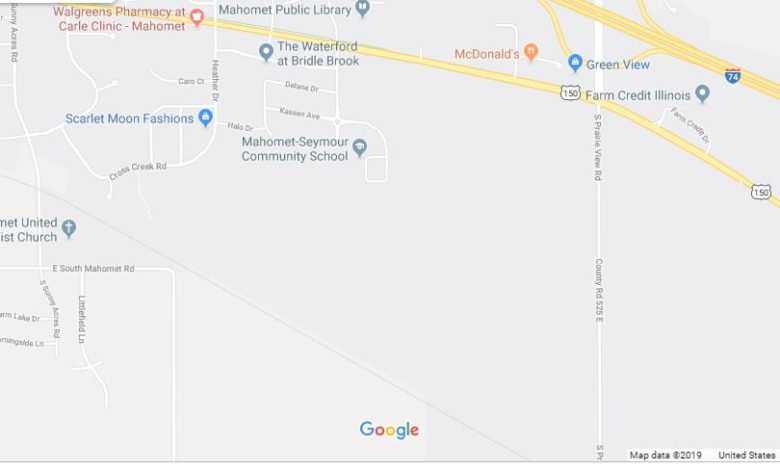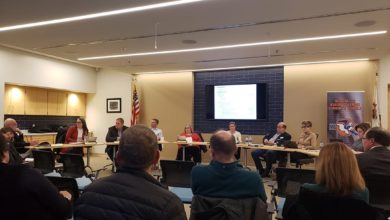Examining a TIF extension: looking at development in the Mahomet community

BY DANI TIETZ
dani@mahometnews.com
The development of land within the Village of Mahomet has been on the minds of residents lately.
Some see the benefit of the continued expansion of Mahomet, both commercially and residentially. Some residents long for the small-town feel that was evident just a few years ago while others are concerned about schools that are bursting at the seams, and empty commercial spaces.
After both the Mahomet-Seymour School Board and the Village of Mahomet Board of Trustees listened to staff plans to extend a TIF district that will expire at the end of 2023, to build a junior high school south of the acreage that Middletown Prairie Elementary currently sits on, to fund a road through the school district’s property, to sell the current junior high and surrounding properties owned by the school district to the Village, to make a recreation center and a public pool, the Mahomet-Seymour School board decided to pause and digest all the information.
On Oct. 15, a little over a month from the first meeting, school board members gathered in what Board President Max McComb characterized as an “investigative” session to discuss the proposed extension.
A TIF can be established by a local municipality to provide the infrastructure that will spur on growth within an area that will not develop on its own or is blighted.
Mahomet currently has two TIF districts, one on the east corridor along IL-150, including the school district’s property, and another one that was established in January of 2019 that includes the “downtown corridor.”
All taxing bodies: the school district, Village, Cornbelt Fire Protection District, Champaign County Forest Preserve District, Parkland College and the Mahomet Public Library receive 50-percent of commercial and 100-percent of residential pass through on the IL-150 corridor TIF.
All taxing bodies do not see pass through on the downtown corridor TIF.
The TIF tax money that is collected can be used for infrastructure that will spur growth within the area, including road, water and sewer lines.
When the school district decided to purchase land within the Conway Farms Subdivision, it established an intergovernmental agreement to build roads on the property at the Village’s request.
As the district begins to look at the next uses of its property, the Village also looks at ways to spur growth on the south side of Mahomet.
In exchange for the district’s support of a TIF extension, which is most likely needed for the State of Illinois to approve a TIF extension, the Village would agree to an Intergovernmental Agreement (IGA) revision, relieving the district from its obligation to construct roads on the property.
The Village would then use TIF funds to construct a $1.8 million road south of the Middletown Elementary, through the school district property, towards South Mahomet Road, where the Village would like to make a railroad crossing.
Money from the Village, including funds from the current TIF district, has been marked to pay for the railroad crossing.
M-S as a Developer
Having built a property within the Village limits, the district now looks at itself as a developer under the Village development guidelines, which are typical among municipalities.
Typically the Village relies on the developer to build infrastructure, including water, sewer and roads, then hands it over to the Village for maintenance. Village Mayor Sean Widener said the Village has built “near zero” roads in Mahomet in the past.
But, the Village wants to change that position in this case.
Its staff believes that developers will not continue the residential and commercial growth on the southeast side of Mahomet unless road, water and sewer lines are extended out to South Mahomet Road.
“The strategy behind TIF is you take the money the TIF generates and you spend on infrastructure in the TIF, and then that helps develop and expand the TIF, and in theory, TIF theory, long-term, there is a payback because you develop that area and development happens and it creates more taxes,” Village Administrator Patrick Brown said.
With developers such as the Atkins Group, Vertical Towers and Purnell Development as land owners to the south and east of the school district property, M-S Board member Colleen Schultz asked if they planned on developing the land or if it was going to remain farm land.
Brown said Atkins and Vertical Towers had long-term plans.
“It all depends on what’s developable and what’s happening at the time,” he said. “They did not buy that land just to farm it.”
Board member Meghan Hennesy asked if the Village knew what would be going into the land to help ensure growth would happen to benefit all taxing bodies after the TIF expired.
Schultz pointed out that because of recent growth along IL-150, that section of town would not qualify as a TIF at this time.
“During the Village meeting, Roger Jackson pointed out to us that this wouldn’t even qualify for a TIF if we were to have a new one,” Schultz recalled.
McComb said that development on Prairieview would likely continue, but that this road and crossing will open up the south part of Mahomet. Drivers will be able to get to IL-150 from South Mahomet without going down Churchill Road on the school district property.
Subsidizing Developers
Currently, there is a gap in land ownership between where the school district owns and where the Village will put the TIF-funded railroad crossing.
“Correct me if I’m wrong, the developer would be responsible for putting their portion of the road in at the time that they develop that, correct?” Hennesy asked.
Village officials did not answer.
Hennesy asked if the property owner would put in its portion of the road, which is projected to be $1.3 million.
Brown said that the Village proposes the use of TIF funds to put all of the roads in so that they are complete.
Hennesy pointed out that there would be about $4.3 million in infrastructure to provide the private entities with what they are looking for.
“It looks to me like then the developers will not be contributing anything to this. It’ll be funded solely by the taxing bodies listed here if it’s through the TIF?” Hennesy asked.
TIF funds must be used or be at least committed by the end of the TIF timeline. With that, the railroad crossing would have to be built by 2024 and the rest of the road would have to be committed because the crossing is not allowed to “go to nowhere.”
Hennesy said she feels that that means the taxing bodies are subsidizing private property owners.
“Am I mischaracterizing this?” she asked. “The only way to get this road built is to do it with the TIF money because there’s nothing that can compel these developers to do that.
“And you’re going to spend the TIF money and you can compel us to do that because we have a piece of land that has development on it, but the only way to make this road work is for us to subsidize for the rest of the developers.”
Widener said he thinks that is a fair statement.
The Village cannot force a property owner to put in infrastructure for development until the land will be developed. But it can make a property owner that currently has development on it to provide public infrastructure.
He said either way, the road would be a long-term goal, and the TIF would be the way to fund it.
“If it were so inviting, it would be built now,” Widener said. “The reality is that it’s not.”
Developers looking
Brown said two businesses, one for-profit and one non-profit, were interested in land along Prairieview Road and the South Mahomet extension, but backed out.
He said that any developer looking at the land sees a poor return on their investment because of the high development costs of the piece of land.
“It’s very unappealing,” Brown said.
Hennesy asked if the Village intends to require the school district to build its portion of the road even if the developer is not ready to move.
Brown said yes.
He believes with the road, the Village will continue to see growth within the TIF district, including commercial growth.
McComb said that he believes the TIF has spurred growth along IL-150, even though he conceded that everyone has different opinions about the development.
Board member Merle Giles said that he agrees that the benefit from commercial development will be greater than the district’s contribution.
“(The Mahomet-Seymour School District’s) presence here helps with commercial developers saying yes,” Giles said.
He noted that the TIF funds help “sweeten the pot.”
Brown said “most developers are not making money on the development, but the return from investment takes years.”
Traffic Flow
Brown said that since the opening of Middletown Prairie, the Village has heard increased feedback from the community about traffic delays on IL-150 east.
The Village has also recognized that the traffic congestion is usually during the school year and during drop-off and pick-up hours.
Mahomet resident Sunny McMurry said that the time she spends dropping her child off at school is the “worst time of her life.”
The proposed road, which will cut the school district property in half from north to south, will be a new route between IL-150 and South Mahomet Road. Currently, residents near South Mahomet Road usually take Sunny Acres Road or IL-47 to IL-150, then head east towards Middletown Prairie or Champaign.
Schultz said that she is concerned about bringing a major road through school property.
Hennesy asked if the district could expect the same traffic as is on IL-150 through the district’s property.
“If that’s going to cut right through the school, that’s a lot of traffic,” she said. “That’s high-volume traffic.”
McComb said school zone speed limits would be in place.
Hennesy said she’s concerned about what that road means for the entirety of the property and what the district can do with it.
Use of Land
Giles said that the school board weighed its facility options about a decade ago, when discussing building a new junior high on the east property after Middletown Prairie was completed.
The measure has never been voted on by the board.
Giles said that in order for the junior high to go on the property, additional access is needed from the south to relieve the traffic to the north.
Schultz pointed out that the junior high isn’t the only need. “All other schools within the district need an addition to accommodate a growing student population.”
She asked if other options had been explored.
Giles said that the board looked at the data and agreed that with the age of the building and it being filled to capacity, the junior high needed to be built next.
Schultz quoted former M-S board member Jenny Park from the spring of 2019 when she asked if there was a point in time when building another house hurts the school district, rather than helping the district.
Schultz cited the answer that every house hurts the district financially because the property tax dollars collected by the district do not equal what it costs to educate a student from year-to-year.
Giles said that the state provides money, too.
Hennesy said that she is not sure that building a new junior high is the answer.
“We can build a junior high and we still don’t have enough space in (Middletown Prairie), we still don’t have enough space at Lincoln Trail, we don’t have enough space in our high school, so I think we have to start looking at how we are projecting our growth,” Hennesy said.
Brown said that residential growth in Mahomet has happened because the school district is a good school district.
“The down side? I don’t think you want the downside,” Brown said. “I don’t think you want no growth and housing. If you have no growth and housing, and people don’t want to move here, then you have other problems.”
Schultz said that she agrees that people move to Mahomet because the schools are wonderful. But she questioned whether or not they’d move here for the TIF.
Henrichs said, maybe.
“There are several other competing school districts around here, too, that are starting to draw from some of those numbers: Monticello’s one, Unity’s one, and St. Joe are all very attractive school districts,” he said.
Schultz cited all the residential development that is already slated within Village limits.
Hall said that the district still has room within the district for more students and classes.
“Currently at the junior high and the high school, the teachers all have plan time in which their classrooms are open and not being taught in,” she said. “And so it is possible, especially at the high school, to utilize those open classrooms.”
Hall said that teachers would travel around the building and go to classrooms that are open throughout the day.
She said that the problem at the junior high is not only classroom availability, but also that the school’s common areas, i.e. the hallways and cafeteria, are not big enough to accommodate the number of students within the building.
According to Hall, the junior high also does not lend itself to the middle school model, or “team” model” that the district employs.
Hennesy went back to the increasing numbers at lower grade levels that will move up through the system.
She pointed out that even at Middletown Prairie, which was built in 2015 and renovated in 2017, there are rooms, such as the cafeteria, being used as classrooms for specials.
During the September meeting, the boards heard that closests at Lincoln Trail were being used as classrooms.
“I don’t think it’s a stretch to say that we’re pushing the maximum on each of these buildings,” Hennesy said.
“Should we be looking at growth in a global fashion so that when we make decisions on how we spend resources, we make decisions that promote the most growth opportunity.”
The discussion turned to other thoughts: like building a new high school and utilizing the district’s current buildings to move grades into spaces with more capacity. The example given would be to move the junior high into the high school and Lincoln Trail into the junior high.
Giles said that Lincoln Trail and the high school have land to expand, but the junior high does not.
“The junior high is the weak link in the bottleneck for all our future plans,” he said.
Schultz said that building the junior high does not eliminate the fact that the other schools would need to have additions.
“We’ve already heard that this building (Middletown Prairie) needs to be expanded within the next five years,” Schultz said. “It just got built.”
McComb asked when the board heard that Middletown Prairie needed to be expanded.
Hennesy said, “Rick Johnston sent an email. His final email said that your five-year plan should include an extension on this building…”
“Because you’re out of space,” Schultz added.
Giles said the cost of a high school would be double that of a junior high.
School Board member Ken Keefe explored the idea of not extending the TIF, but using the full tax dollars after the TIF expires to fund lower class sizes.
“If we lower class sizes, we have to have more classes, which we don’t have room for presently,” Larson said.
Schultz said that while she does believe that short-term loss for long-term gain is a good way to look at things, the needs of the Mahomet-Seymour school district at this juncture are too great to overlook.
“I just don’t feel like we can give up any short term money right now because in the short term we have to spend the money to solve these problems, and they are substantial problems that we have to solve that are not cheap in any way,” she said.
Looking at Funds
According to Village projections, which are based on a 2-percent growth model, the amount the school district would be required to bond for in order to fulfill its infrastructure agreement and the amount it would lose out on in TIF funds in the 12-year extension, is $750,000.
The Village said that giving up that money in the short-term would benefit the school and all taxing entities with the benefits of development in the long-term.
Brown said the TIF extension option is the least expensive option for all parties.
Schultz stated that the school district might be losing money on the proposed deal.
The Village has projected roughly $8 million in TIF funds with the extension.
Schultz pointed out that the district receives 56-cents on the dollar of tax monies.
“Then we are contributing a lot more than $1.8 million.” she said.
“I don’t know that we have the extra money to not do the things we need to do, especially with the influx of students we have coming in,” she said.
“That to me is a concern.”
Widener reminded the board that the Village does not have the money either, so if the TIF extension doesn’t happen, then the road doesn’t happen.
“That would be unfortunate for everybody involved,” he said. “Not only for the taxing bodies but the residents as well.”
Hennesy wanted to know if the district could give up its TIF money until the time that there have been enough funds collected to pay for the infrastructure and then receive a pass-through on all tax dollars within the TIF after.
Hennesy said that the school district is charged with the task of educating children, and now that they have become developers by building Middletown Prairie Elementary, maybe they are “out of their core competency.”
McComb said that property tax gains with new development should also be considered.
Jackson said that if a home pays $10,000 a year in property taxes, and there are 100 homes built, the district will see $1 million per year in property tax gain. The district only receives 56-cents on the dollar for property taxes, though, so the district would not capture that amount.
Hennesy said that it will also be 100 homes full of kids that will go to the school.
“We can’t just think of this as a developer because we then have an influx of kids and an influx of infrastructure that we are responsible for as a school district that we already don’t have capacity for in each of our buildings,” she continued.
“Once you start building, you have to be able to house those kids.”
Brown said that homes built in Mahomet provide the district with more tax dollars than other homes provide for their taxing entities throughout Champaign County because of the home values in Mahomet.
Giles said he thinks apartment complexes with kids would be more damaging to the district than a single-family home because of the tax value to the district.
Hennesy said the district cannot dictate what is developed on the property.
Giles talked about how the road will entice a variety of development on the south side of town, including commercial.
“We have commercial sitting empty,” Hennesy said.
Keefe brought up the demography presentation that both boards commissioned in early 2019. Within that presentation, the boards heard about the chance for another upcoming recession. He said that if a recession hits, the TIF district extension could be “all for nothing” if developers hold off for a few years.
Keefe also noted the demographer’s statistic that more people will be trying to sell their homes than buy homes because of baby boomers leaving their nest.
McComb said the trend in Mahomet is shifting from Mahomet being a place to raise their children and then leave to ones who are staying because of established relationships.
New Benefits
Giles said that the quality of life has shifted in Mahomet because of the recent commercial development.
“Now you can get Jimmy John’s here,” McComb said.
Two TIF Districts
Schultz pointed out that while she thinks it’s great that Mahomet has a Jimmy John’s, the school district will miss out on the benefits of that commercial property tax money because of a second TIF district that was established by the Village of Mahomet earlier in 2019.
The discussion was a surprise to several board members who did not realize that Jimmy John’s was in a TIF district.
Giles said there is only one TIF district in Mahomet, but the Village confirmed that there was a second TIF district established, with no pass through, in Mahomet’s “downtown area,” which includes the property that Jimmy John’s recently built on.
When asked, Brown said that TIF will go another 23 years.
McComb described it as a “savings bond.”
Schultz said, “we will have kids who grow-up, get married and have kids, their kids are going to grow up and graduate high school before we see a dime of that money from anything in that corridor.”
Schultz asked if there had been a study done on the impact of having two TIF districts
“People ask me all the time, why would we want commercial growth,” she said. “We want commercial growth because that’s a great way to diversify our tax base, but not anymore because the whole commercial core is in a TIF, and now this is going to be.”
McComb said that the development produces payroll, which results in sales tax dollars.
Schultz questioned how the TIF was passed without the school district knowing about it.
Superintendent Hall and Chief Financial Officer Trent Nuxoll were at the TIF meeting in January, but some M-S board members did not know the decision had been made.
The Community Price Tag
“Any substantial building project that we are going to build, whether it’s a high school, junior high or multiple additions at the same time, most probably exceeds what we will be able to do without a tax increase,” McComb said. “Therefore, anything we do is going to be run by the voters.”
The district and Village said there is not yet a timeline on when they will have to go to the taxpayers.
But McComb believes that the community would be more likely to accept the lower price tag of a junior high than that of a high school.
He added that in years past, the strategy of the district has been to build buildings that accommodate the immediate need with room to expand in the future.
Keefe asked if the community would get a variety of options during community engagement.
Members agreed that hadn’t been discussed yet.
Giles said there is not enough land by Middletown to build a high school. Keefe and Henrichs thought it might be an interesting idea to ask the property owner to the west if they might be interested in a land swap so that the district keeps a chunk of land west of the road and the developer would be closer to other commercial and residential development.
“It also keeps our kids away from the train tracks,” Keefe said.
More Needs and Costs
Should the district move out of the junior high, part of the TIF extension understanding will include that the Village will be allowed to purchase the junior high, Middletown Field and 13 Acres for $750,000.
The Village said they are working on funding for that purchase, but to tear down half of the building, turn it into a MARCC Center and build a swimming pool, they would also need additional tax dollars from the taxpayers.
Attendee Feedback
Laura Lang said that as a resident on South Mahomet Road, she would enjoy the access to the schools from the southeast, but is concerned about the overpopulation of the schools.
“Would we like the road, just like my teenager would love a new car? Absolutely, but does she need something more than a hot car, she does. And I think our schools are just packed out. And even with what is being developed at this moment, we really have to consider putting the space first. Not only for the kids, but for the teachers,” she said.
“We’re talking about people coming to our district because the education is so good, but that’s not going to stay at the level it’s been at my entire childhood and into my kids’ if we don’t give the teachers the space and the resources that they need.”
Lance Raver said that there is a lot of value added to the community in building the road that opens up the south side of town.
McMurry said that she sat on a committee when the district first purchased the land, and thought that maybe her oldest, would be able to benefit from that purchase at some time.
“The conversations that are happening are not for the here and now,” she said.
She said it’s about thinking about how the district can capitalize on the space it already owns.
“We can’t do that without an additional roadway leading into it,” she said.
She said that adding on to current buildings will not be a long term fix.
Next Steps
Towards the end of the meeting, the entities agreed that they needed to take a deeper dive into the subject.
The Mahomet-Seymour School District will begin a community engagement project in December.
McComb said the fact that the Mahomet-Seymour community will have to vote on a tax increase is why they will begin a community engagement process in 2020.
“We want to have a heart and a feel for where the community is,” he said.
How much the district would have to ask for depends on the feedback the district receives.





